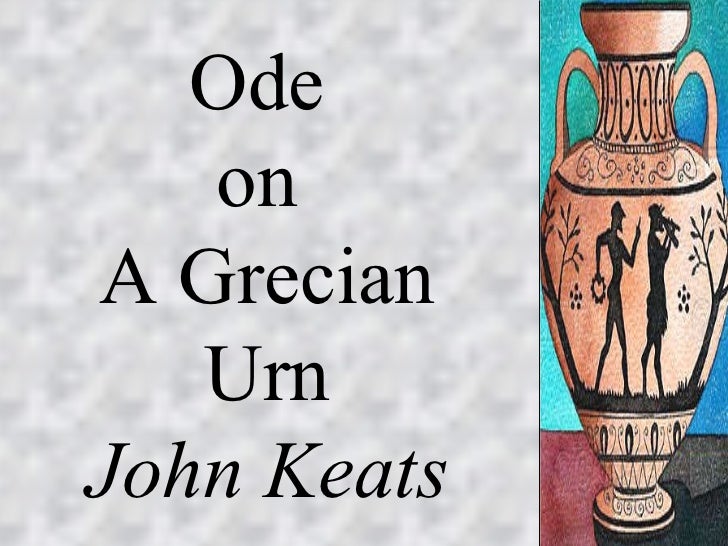
Ode on a grecian urn
Poem Guide John Keats: "Ode on a Grecian Urn" How to read the most famous poem "for ever." By Camille Guthrie Oil on canvas by Joseph Severn (1793-1879), 1821-1823. London, National Portrait Gallery (Photo by DeAgostini/Getty Images) It's hard to be human.

Dionysos and the Symposium Ancient greek pottery, Ancient greek art
" Ode on a Grecian Urn " is a poem written by the English Romantic poet John Keats in May 1819, first published anonymously in Annals of the Fine Arts for 1819 [1] (see 1820 in poetry). The poem is one of the "Great Odes of 1819", which also include "Ode on Indolence", "Ode on Melancholy", "Ode to a Nightingale", and "Ode to Psyche".

"Ode on a Grecian Urn" by John Keats (read by Tom O'Bedlam) YouTube
KEATS'S IDEAL IN THE ODE ON A GRECIAN URN By Jacob D. Wigod T100TED in awareness of pain and flux, Keats's odes -?-^ the poet's desire to escape the painful actual and beauty, in the ideal. More than any other of the odes, ject of the Ode on a Grecian Urn is the ideal itself. While of art is the poet's bulwark against flux, it is not the

Ode on a Grecian Urn by John Keats Analysis Info4Now
by John Keats Analysis PDF Cite Last Updated October 20, 2023. Throughout "Ode on a Grecian Urn," the speaker experiences a wide range of emotions and feelings regarding the urn's.

mehta kavita Ode on a Grecian urn John Keats
"Ode on a Grecian Urn," written in 1819 by John Keats and published anonymously in Annals of the Fine Arts, is one of the "Great Odes of 1819." The other odes in the sequence include "Ode on Innocence," "Ode on Melancholy," "Ode to a Nightingale," and "Ode to Psyche."
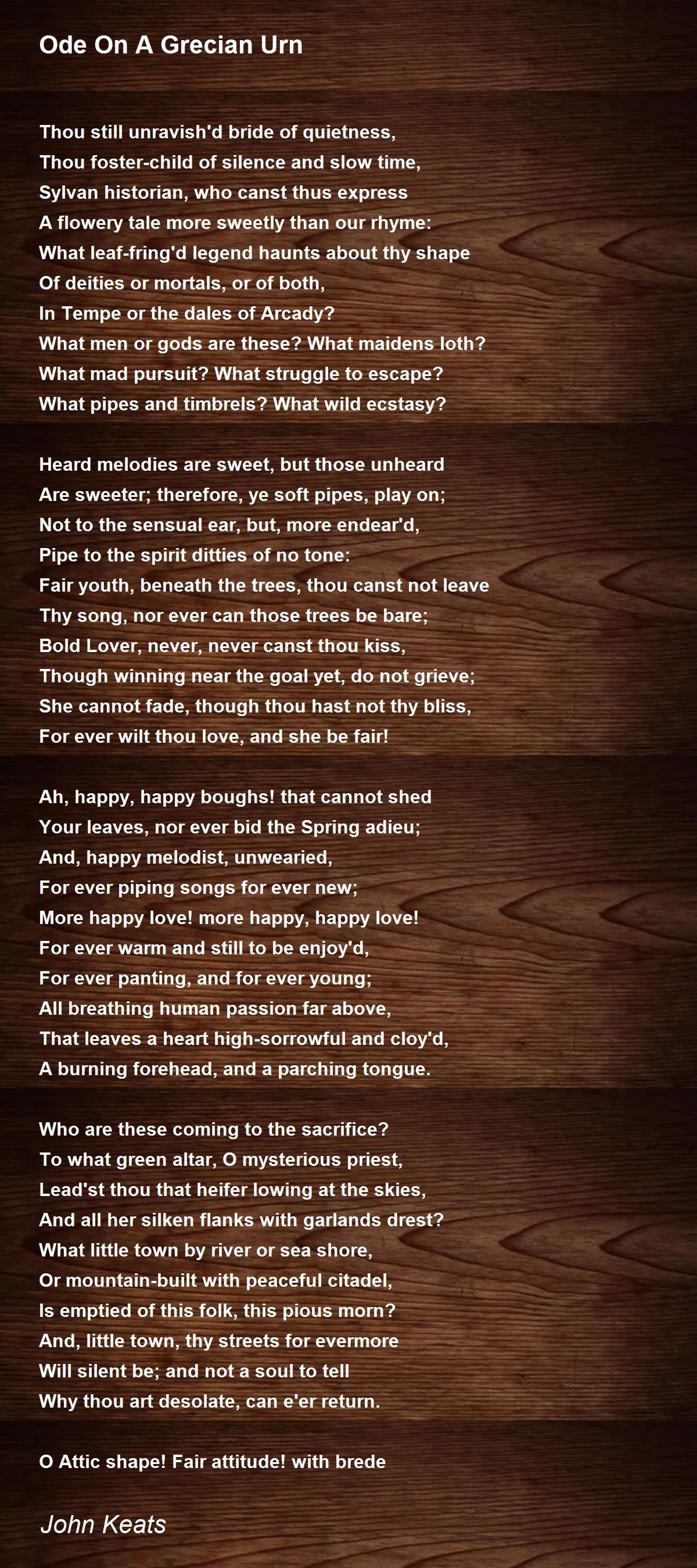
Ode On A Grecian Urn Poem by John Keats Poem Hunter
'Beauty is truth, truth beauty': this, the words on John Keats's Grecian urn proclaim, is all we know, and all we need to know. 'Ode on a Grecian Urn' is one of the most celebrated poetic achievements of the Romantic poet John Keats (1795-1821), so is perfect for our next stop on this poetry odyssey, Post A Poem A Day, which sees us sharing some of our favourite classic poems.

mehta kavita Ode on a Grecian urn John Keats
Ode on a Grecian Urn, poem in five stanzas by John Keats, published in 1820 in the collection Lamia, Isabella, The Eve of St. Agnes, and Other Poems. The ode has been called one of the greatest achievements of Romantic poetry, and it is also one of the most widely read poems in the English language. The poet describes a scene on an urn that.
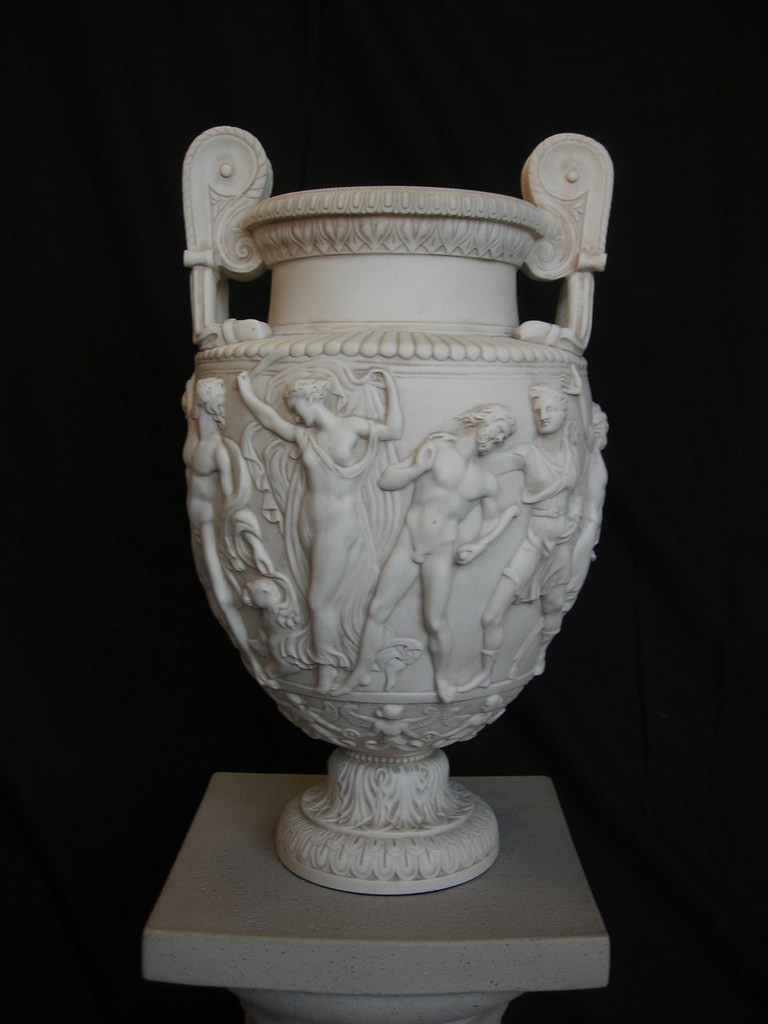
Ode on a Grecian Urn Springwood Press
John Keats 1795 - 1821 Thou still unravish'd bride of quietness, Thou foster-child of Silence and slow Time, Sylvan historian, who canst thus express A flowery tale more sweetly than our rhyme: What leaf-fring'd legend haunts about thy shape Of deities or mortals, or of both, In Tempe or the dales of Arcady? What men or gods are these?
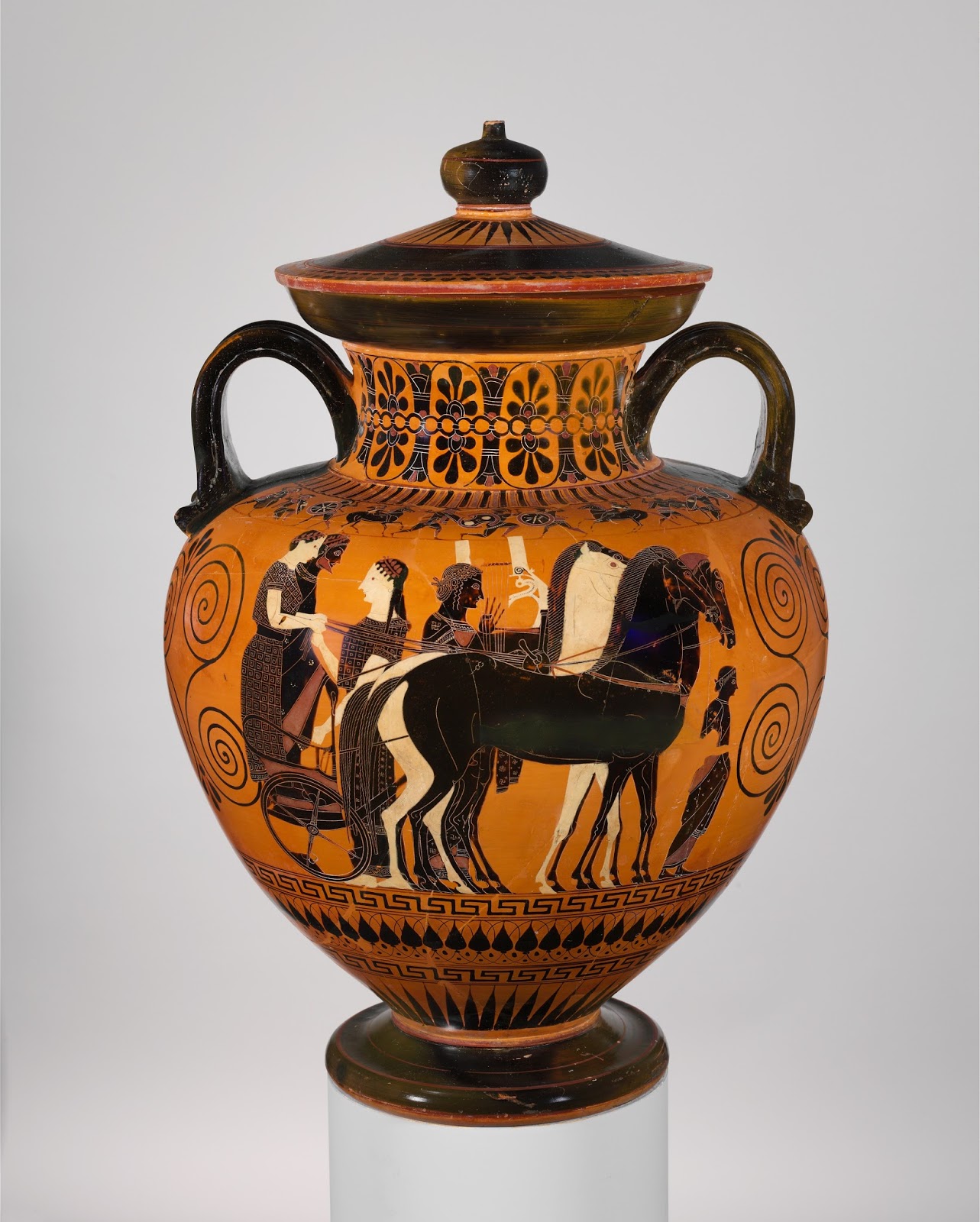
ravalmital "Ode on a Grecian Urn" bt John Keats
By John Keats Thou still unravish'd bride of quietness, Thou foster-child of silence and slow time, Sylvan historian, who canst thus express A flowery tale more sweetly than our rhyme: What leaf-fring'd legend haunts about thy shape Of deities or mortals, or of both, In Tempe or the dales of Arcady? What men or gods are these? What maidens loth?
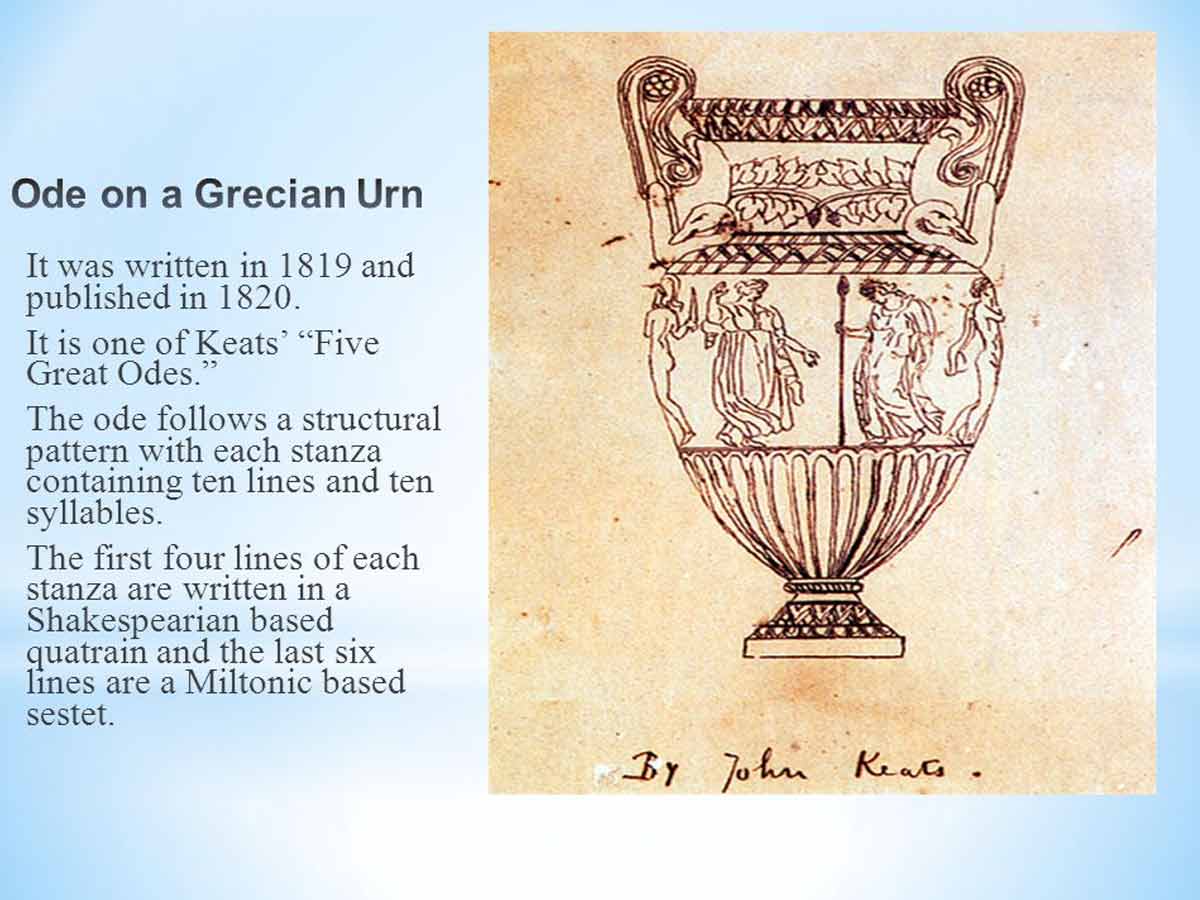
7 John Keats works every man should read in life
Ode on a Grecian Urn by John Keats Thou still unravish'd bride of quietness, Thou foster-child of Silence and slow Time, Sylvan historian, who canst thus express A flowery tale more sweetly than our rhyme: What leaf-fringed legend haunts about thy shape Of deities or mortals, or of both, In Tempe or the dales of Arcady? What men or gods are these?

💄 Ode to a greek urn. Summary of Ode on a Grecian Urn by John Keats
Keats's Negative Capability is evident in 'Ode on a Grecian Urn' in the 'mysterious' nature of the urn, which offers the viewer partial glimpses and hints of a long-vanished civilisation. It isn't necessary to learn more than the fact that beauty is truth, and truth in turn is beautiful: this is, after all, enough.

Grecian Urn John Keats Pinterest
'Ode on a Grecian Urn,' an ekphrastic poem, is one of John Keats' "Great Odes of 1819." "Beauty is truth, truth beauty,—that is all," a line that captures the essence of Keats' confidence in the power of art. Read Poem Poetry+ Guide Share Cite John Keats Nationality: English

ravalmital "Ode on a Grecian Urn" bt John Keats
'Ode on a Grecian Urn' is one of the best-known and most widely analysed poems by John Keats (1795-1821); it is also, perhaps, the most famous of his five Odes which he composed in 1819, although ' To Autumn ' gives it a run for its money.

Ode on a Grecian Urn by John Keats (Poem + Analysis)
"Ode on a Grecian Urn" was written by the influential English poet John Keats in 1819. It is a complex, mysterious poem with a disarmingly simple set-up: an undefined speaker looks at a Grecian urn, which is decorated with evocative images of rustic and rural life in ancient Greece.

John Keats "Ode to a Grecian Urn" (1820) YouTube
Keats's Ode to a Grecian Urn?For Ulrich Keller THEY WHO MISQUOTE THE TITLE OF KEATS'S ODE MAY NOT BE AWARE OF the truth in their mistake. Indeed, Keats's poem is an ode not "on" but "to" a Grecian urn, most conspicuously so as it opens with a threefold apostrophe1 and thereby fulfils the requirements of the genre more faith fully than most odes.

John Keats Ode on a Grecian Urn Genius
The Poetical Works of John Keats by John Keats. Ode on a Grecian Urn. To Autumn. →. ODE ON A GRECIAN URN. Thou still unravish'd bride of quietness! Thou foster-child of Silence and slow Time, Sylvan historian, who canst thus express. A flowery tale more sweetly than our rhyme: